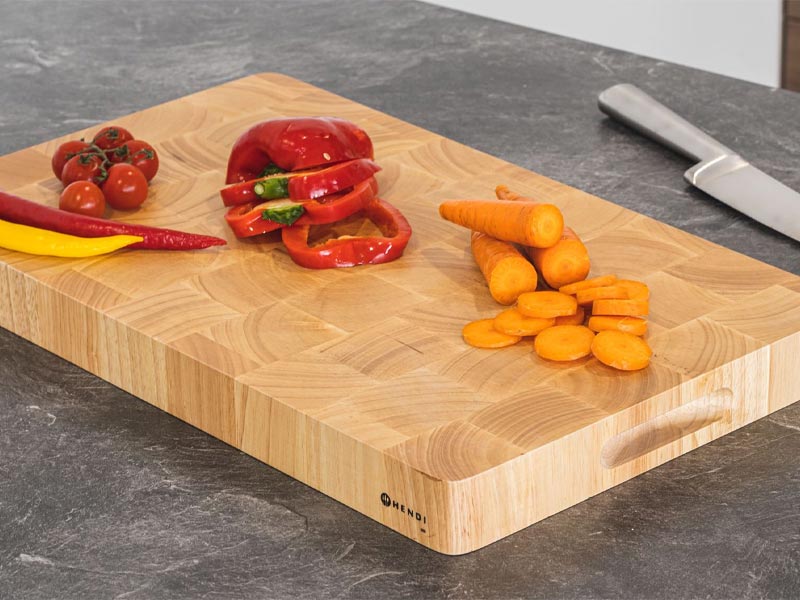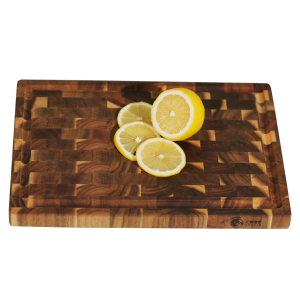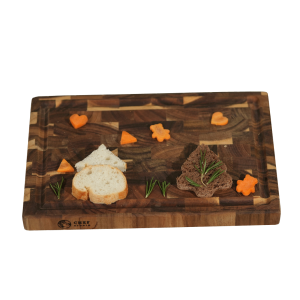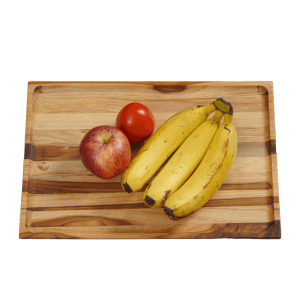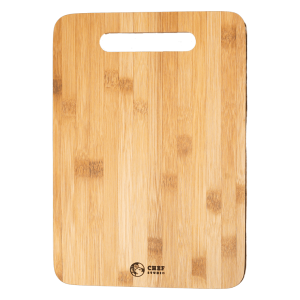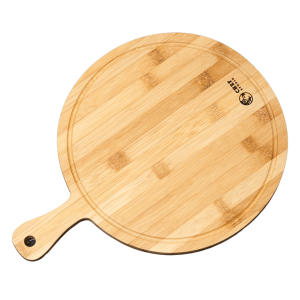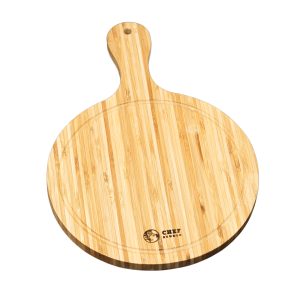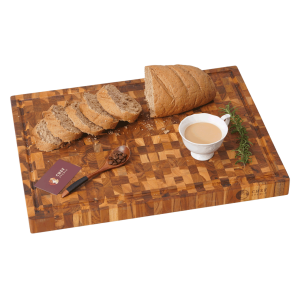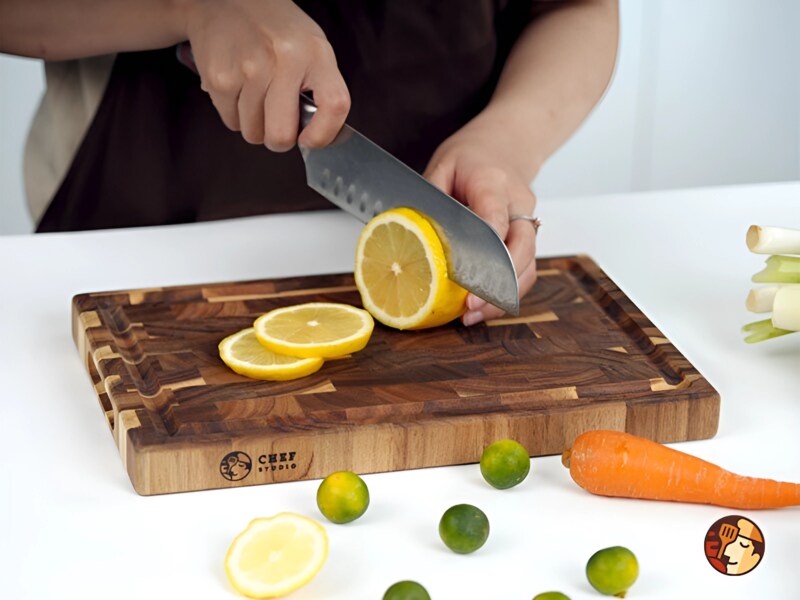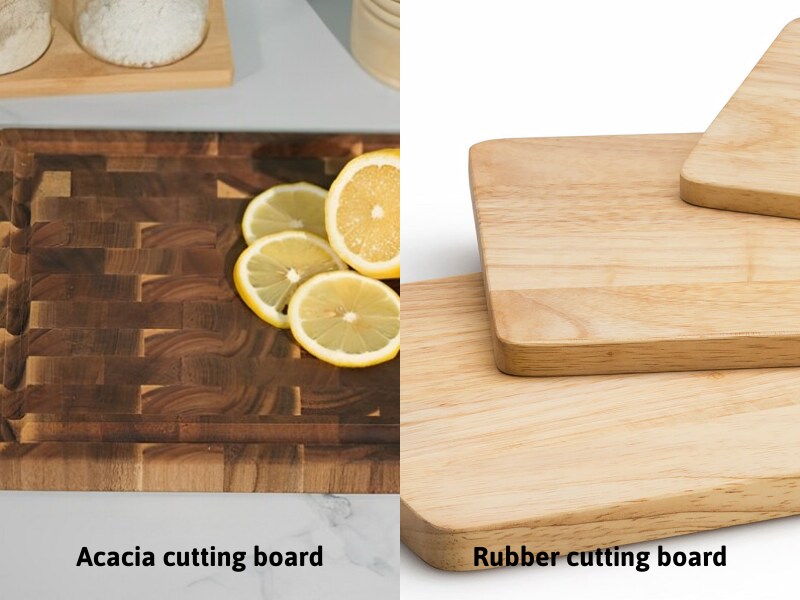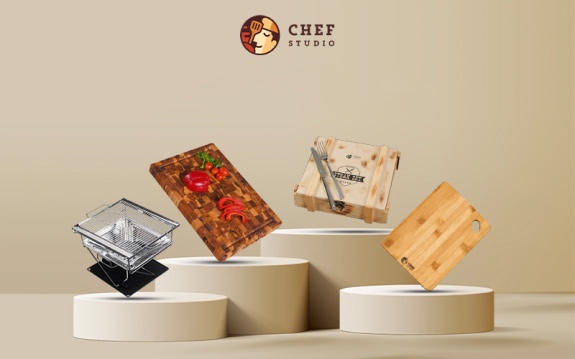Compare Rubberwood vs Acacia cutting board
When it comes to selecting the ideal cutting board for your kitchen, the possibilities appear unlimited. Two popular choices among homeowners are rubberwood and acacia cutting boards. In this article, Chef Studio will compare rubberwood vs acacia cutting boards to help you make an informed decision for your culinary adventures.
Are rubberwood cutting boards good?
Before comparing rubberwood vs acacia cutting boards, let’s learn about each product. Rubberwood cutting boards have garnered attention for their unique blend of benefits and drawbacks, making them a noteworthy contender in the kitchen.
Pros
- Extra-sanitary: Unlike porous materials such as wood and plastic, rubberwood boasts non-porous properties. This means that liquids are repelled rather than absorbed, reducing the risk of bacterial contamination and simplifying the cleaning process.
- Great for Knife Sharpness: The soft nature of the rubberwood minimizes friction during knife strokes, preserving the sharpness of blades for longer periods. This feature is particularly beneficial for maintaining the edge of high-quality knives commonly used in professional kitchens.
- Higher Quality Materials: Rubberwood cutting boards are known for their durability and resistance to warping. Unlike flimsy plastic alternatives, rubberwood boards offer a sturdy cutting surface that enhances safety during food preparation.
Cons
- More expensive than plastic ones: Rubberwood cutting boards come with a higher price tag compared to plastic options. While the investment may be justified for those prioritizing quality, it may deter budget-conscious consumers.
- Not Dishwasher Friendly: Hand washing is necessary for rubberwood cutting boards, as they are not suitable for dishwasher use. Exposure to high temperatures can cause warping, compromising the integrity of the board.
- Weight (for some users): The weight of rubberwood cutting boards, especially larger ones, may be cumbersome for some users. However, thinner rubberwood boards offer a lighter alternative for those concerned about weight.
Overall, rubberwood cutting boards offer a unique combination of sanitation, knife-friendly properties, and durability. While they may come at a higher price and require hand washing, their superior performance and longevity make them a worthwhile investment for those seeking quality kitchen tools.
Read more: Is rubber wood good for cutting boards?
Are acacia cutting boards good?
Are acacia cutting boards good? This question often arises when considering options for kitchen essentials. Let’s delve into their advantages, and potential drawbacks before considering rubberwood vs acacia cutting board.
Advantages
- Durability: Acacia wood is renowned for its durability, thanks to its dense grain and tight fibers. Its hardness makes it resistant to cuts and scrapes, ensuring longevity even with regular use in the kitchen.
- Aesthetic Appeal: Available in a range of colors from light to dark brown, acacia wood boasts captivating grain patterns with swirls, streaks, and knots.
- Ease of Maintenance: Maintaining an acacia cutting board is a breeze. Regular hand-washing and oiling help preserve its appearance and prolong its lifespan, keeping it looking as good as new for years to come.
- Knife-Friendly: Acacia wood is gentle on knives, preventing dulling and damage to blade edges. Its sturdy construction ensures that knife marks are minimized, preserving the integrity of the board.
Disadvantages
- Difficulty in Repairing Scratches: Scratches that go against the grain on acacia wood can be challenging to rectify. This may detract from the appearance of the board over time, requiring extra care during use.
- Color Darkening: Exposure to air and light can cause acacia wood to darken over time, gradually losing its original light color. While some may find this natural aging process appealing, others may prefer a cutting board that maintains its initial hue.
- Unpredictable Grain Structure: The grain structure of acacia wood can vary unpredictably, with some boards containing knots or blemishes while others feature a straight grain. This inconsistency may affect the overall aesthetics of the cutting board.
Acacia cutting boards offer a balance of durability, aesthetics, and maintenance ease, making them a suitable choice for many kitchen enthusiasts. However, potential buyers should consider factors such as weight, cost, and availability before making a purchasing decision.
Rubberwood vs Acacia cutting board – Which is better?
Rubberwood and acacia cutting boards are both popular choices for kitchen enthusiasts, each offering distinct advantages and considerations. Chef Studio will compare rubberwood vs acacia cutting boards to determine which one is better.
Durability and Maintenance
Acacia cutting boards boast exceptional durability, resisting wear, water absorption, and warping. Like rubberwood, they require minimal maintenance, with regular cleaning and occasional oil or beeswax treatment to preserve quality.
Environmental impact
When comparing acacia vs rubberwood chopping boards, you should consider their impact on the environment. Both rubberwood and acacia cutting boards contribute positively to the environment due to sustainable harvesting practices, utilizing resources efficiently, and minimizing waste.
Rubberwood vs Acacia cutting board cost
Rubberwood cutting boards are generally more affordable than their acacia counterparts, but the price difference may vary based on size and quality. Both offer excellent durability, ensuring long-term value for your kitchen.
Aesthetic appeal
Appearance is an indispensable element when choosing acacia wood vs rubberwood cutting board. Acacia cutting boards are celebrated for their rich grain patterns and warm hues, elevating the kitchen’s aesthetic. In contrast, rubberwood boards have a more uniform appearance, which may be less visually appealing to some.
Making the right choice
Consider your priorities, budget, and aesthetic preferences when choosing rubberwood vs acacia cutting boards. While rubberwood may offer affordability and simplicity, acacia provides elegance and sophistication, making it a worthwhile investment for those willing to spend a little more.
In conclusion, the choice of rubberwood vs acacia cutting boards ultimately depends on your preferences, priorities, and budget. Rubberwood cutting boards offer sustainability, durability, and affordability, making them a practical choice for many kitchens. On the other hand, acacia cutting boards boast exceptional durability, water resistance, and visual appeal, albeit at a slightly higher cost. Whether you opt for the affordability of rubberwood or the elegance of acacia, both options provide reliable and low-maintenance kitchen companions that will serve you well for years.

